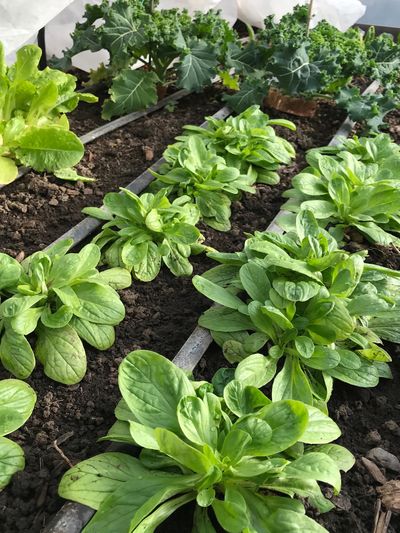In the Garden: Choose the right crops and covers for year-round gardening

Over the years, I’ve let the seasons dictate when I grew a garden. I’d begin in early spring and put it to bed when the frosts arrived in the fall.
In 2014, my routine changed after reading Eliot Coleman’s book, “The Winter Harvest Handbook” (Chelsea Green Publishing, 248 pp., $29.95). In it, I learned that it’s possible to garden 12 months of the year – outside and without using supplemental heat. Coleman underscores the importance of selecting cold-hardy vegetables, including some greens I’d never grown before, and using covers to keep the plants warm enough.
Four years ago, my husband and I built a hoop house, which is a plastic-covered greenhouse. It fits over two of our raised beds and works great for this purpose.
It’s still possible to be successful with a much simpler set-up. Some sturdy hoops, a sheet of floating row cover and a sheet of clear plastic are all that’s required. The hoops need to be strong enough to support a snow load. If we hadn’t built the hoop house, we would have fashioned hoops from black plastic sprinkler pipe or electrical conduit.
While it might be hard to think about cold weather when it’s so hot outside, this is the time of year to start seeds for a winter garden. That’s because it’s crucial that plants form a good root system before the temperatures drop in the fall.
The crops I’ve had the best luck with include kale (Vates or Winterbor), corn salad (mache), miner’s lettuce (claytonia), lettuce (Speckled Trout or red romaine), and spinach (Matador, which is exceptionally cold-tolerant).
Of those, the kale, spinach and lettuce should be started indoors now and transplanted to the winter garden bed once they have a few true (mature) leaves. The corn salad and miner’s lettuce can be direct-sown in the bed as they don’t like their roots disturbed.
Put the hoops in place across your winter garden bed, spaced about 2 feet apart for the length of the bed.
When the frosts start, cover the bed with a sheet of row cover for a few degrees of frost protection. This lightweight fabric allows sunlight and moisture to go through it, and it can be found in large garden centers or online.
Once the weather gets colder, add a sheet of plastic over the row cover to provide extra warmth. If the weather temporarily warms up, be prepared to open an end of the plastic so the plants won’t fry. Keep an eye on the soil moisture in the early days as well; once the temperatures remain chilly, the condensation inside the plastic tunnel will drip down and water the plants for you.
I’ve occasionally had to deal with slugs, which you’d think would die during our winters; unfortunately, they don’t. There are organic slug baits available or you can make beer traps. This involves sinking empty tuna or cat food cans into the soil – with their rims at the soil surface – and pouring an inch of beer into the cans. Attracted to the smell of the yeast, slugs come to investigate, fall in and drown. Another option is to occasionally go out to the garden at night, armed with a flashlight, to look for slugs and eliminate them.
Other than being observant for such things, you will quickly find that the only work involved in growing a winter garden is to harvest and enjoy your fresh salad greens.
To learn more about winter gardening, watch this week’s “Everyone Can Grow A Garden” video on youtube.com/c/susansinthegarden.
Susan Mulvihill is co-author, with Pat Munts, of “Northwest Gardener’s Handbook.” Contact her at Susan@susansinthegarden.com.